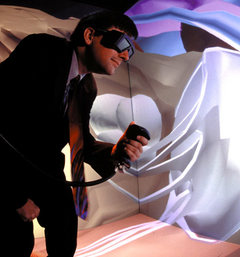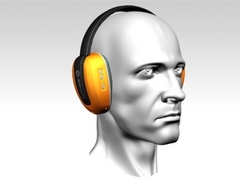Tag: Computers
DecideIT software helps you make better decisions
If you don’t have a mentor to teach you about risk management the alternative is DecideIT, the software that helps you figure out if you’re doing the rational thing. “It is based on unique algorithms that make it possible to deal with and analyze complex decision-making situations, even in cases where precise information is not available. It is often sufficient to use probabilities, utility values, and weighting in the form of comparisons or intervals, but the tool also informs the user where more resources should be used to obtain a better basis for making a decision.” [GT]
DecideIT [via Gizmag]
RUEBEN the ROBOT vintage travel alarm
Rueben the clock-bot is 16cm tall, 10cm wide, and made from a vintage 1940’s Westclox bakelite travel alarm, bakelite #7 pool ball, old faucet handle, bakelite dice and vintage wood dominos. Since Rueben sports a vintage alarm, he also helps you do a cubist re-enactment of Day of the Triffids. $55. [GT]
Mini Castle alarm goes right in the ear
I’ve gotten pretty proficient at whacking the little button on my alarm clock until it shuts up, and then going back to sleep for 1-3 hours, so the Mini Castle in-ear alarm is mixedly appealing. Slightly larger than a typical earbud, it fits right in your ear and when it goes off, it’s pretty likely you’ll hear it. Available in black, white, pink or green. $15. [GT]
Mini Castle in-ear alarm [Oh Gizmo]
'Caveman' provides 4d rendering of the human body
Canadian researchers have developed ‘Caveman’, a 4 dimensional model of the human body – the fourth dimension being time – which is so huge that over 3,000 distinct body parts are accessible. The viewing booth involves 3D goggles and a game-style joystick. “We say that killing monsters is fun, but curing cancer is more important,” commented Andrei Turinsky, a mathematician and computer scientist at the Visual Genomics center. ‘Caveman’ will allow researchers to develop greater understanding of diseases like cancer, diabetes, muscular sclerosis and Alzheimer’s. [GT]
SONOS announces multi-room music system for £699
Since not everybody has more than £699 to spent on a new wireless multi-room music system, SONOS has announced their new bundle will cost exactly that. The BU130 bundle from SONOS will include “a ZP80 which can be connected to an existing stereo or home theater receiver to instantly make it part of a digital music system; a ZP100 which can be connected to speakers and placed in any room; and a CR100 providing wireless multi-room control of all your music from any room in the house.” SONOS’s gear is compatible with Audible, Napster, eMusic, Pandora, Rhapsody, Yahoo!’s Music Unlimited, the Zune Marketplace and some other doubtless equally delightful vendors. [GT]
BU130 bundle from SONOS
Sign & Seal is magnetically adorable
I’m picky about my pens, but might make an exception for the cute little Sign & Seal that balances eternally atop a little plastic nose. In true seal fashion, courtesy of super-powered magnets embedded in its plastic body you can even spin the pen with the most tasteful little tap of your finger. $10. [GT]
Sign & Seal [via Nerd Approved]
Sensear protects your ears and fills them with knowledge
The Sensear noise-cancelling, audio-enhancing headphones use multiple directional microphones in order to reduce Noise Induced Hearing Loss (such as that experienced by rock musicians) and also uses a massive set of algorithms to filter out the nonsense and provide clear communication. It’s also Bluetooth enabled, so the wearer can wander freely (though will resemble someone on his way to shoot up a paper target). The Bluetooth also allows integration with your mobile so you don’t have to keep shouting “WHAT? NO, I DON’T WANT ANY CHICKEN LIVERS.” Release date is September 2007; price TBA. [GT]
Chinese scientists continue thumbing nose at nature
If rain approaches Beijing during the summer Olympics in 2008, cloud-seeders will go aloft with silver iodide to force premature rainfall to prevent it from reaching the Olympic grounds. China employs 1,500 weather controllers which have eliminated hail in almost a half million square kilometers of land and created 250 billion tons of rain since 1999. By 2010 China intends to institute a national command center to co-ordinate the China Meteorological Administration with the military forces used to enforce their whims on nature. Apparently Three Gorges Dam was just a side project! [GT]
KornTech's $1 million Rogun robot can get to know you

Korean company KornTech’s one-meter tall robot, Rogun, can walk (which is actually trickier than it looks), learn to recognize its masters’ faces and voices, and has a 7″ LCD in its stomach so that your children can think of it as a walking, talking TV. It can even route video phone calls through to its midriff if you like the idea of bending over to talk to people who aren’t even in your house. It may not really cost a million dollars; translating dollar figures can be tricky, but given what it does, it probably is pretty expensive for how cute it is. [GT]
Hitachi RFID chips sleeps on the Singapore fishes
Keeping track of what fish is which can be difficult when there’s only a few of them, and when you’ve got a whole aquarium featuring hundreds of identical swimmers it can be close to an idiot savant talent. Underwaterworld Singapore has streamlined the process by using Hitachi RFID dust to tag individual fish with a lightweight payload that lets aquarium visitors easily tell an arapaima from a pacu. When the fish swims past a sensor, the name of the fish is displayed. The system cost a little under £10,000 to set in place and will be extended soon to include their shark population. [GT]

























